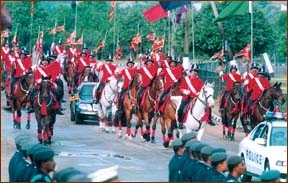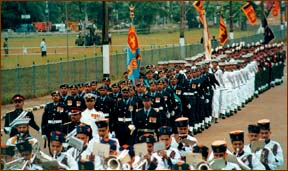|
Prelude to Independence
by Aryadasa Ratnasinghe
The Portuguese ruled the maritime settlements of the island for
153 years (1505-1658), the Dutch for 138 years (1658-1796)  and the
British for 19 years, until the capture of the Kandyan kingdom and
signing the Kandyan Convention on March 2, 1815. Thereafter, they
continued to rule the whole island up to 1948, as colonial
administrators under the British Crown, until the country gained
Independence on February 4, 1948, after 443 years of foreign
domination. and the
British for 19 years, until the capture of the Kandyan kingdom and
signing the Kandyan Convention on March 2, 1815. Thereafter, they
continued to rule the whole island up to 1948, as colonial
administrators under the British Crown, until the country gained
Independence on February 4, 1948, after 443 years of foreign
domination.
On February 16, 1796, Colombo was surrendered to the British
forces and after capitulation, the country was placed under the
Government of Madras and the administration was entrusted to
brigadier-general Pierre Frederic de Meuron, assisted by three
civil officers stationed in Colombo, Galle and Jaffna.
The sovereignty of Sri Lanka and the government were vested in
the British Crown and until further provisions were made for the
administration of the country, Frederick North arrived in the
island on October 12, 1798 and assumed duties as the King's
representative responsible for the Home Government in England.
Among other things, he was advised to look into matters connected
with trade and commerce. On January 1, 1802, Sri Lanka became a
Crown Colony under the Colonial Office in England.
 On April 11, 1829, there arrived in Sri Lanka, Lieut. Col.
William Macbean Colebrooke,and along with him came Charles Hay
Cameron. Both were commissioned by the Home Government to inquire
into and report on the administration of the government and on the
judicial establishments and procedures of the country. According
to William Digby of the Colonial Office, the immediate occasion
for the appointment of the Royal Commission, was the financially
disastrous situation of the Colony, under the Governorship of Sir
Edward Barnes. On April 11, 1829, there arrived in Sri Lanka, Lieut. Col.
William Macbean Colebrooke,and along with him came Charles Hay
Cameron. Both were commissioned by the Home Government to inquire
into and report on the administration of the government and on the
judicial establishments and procedures of the country. According
to William Digby of the Colonial Office, the immediate occasion
for the appointment of the Royal Commission, was the financially
disastrous situation of the Colony, under the Governorship of Sir
Edward Barnes.
The Commission strongly recommended a series of reforms,
including the abolition of land tenure by personal service ('rajakariya'),
the establishment of Legislative Council and an Executive Council
and an independent judiciary and opening the doors of the public
service to all classes of the native population, according to
their qualifications. Governor Barnes strongly condemned the
report of the Commission when nationals were allowed to enter the
Ceylon Civil Service, which was a prestigious position exclusively
enjoyed by Europeans.
Another important recommendation made by the Colebrooke
Commission had far-reaching effects. The first and foremost was to
amalgamate the Kandyan and Maritime provinces into one unitary
government with an uniform administration, because the maintenance
of two separate states was considered most unpolitic, but only
conducive to the benefit of the chiefs, though detrimental to the
Kandyan people. Next was the division of the island into five
provinces with Colombo, Kandy, Galle, Jaffna and Trincomalee as
capitals, for easier administration.
The demand for an effective participation in the government of
the Colony and the introduction of the elective principle, in
filling the seats of the Legislative Council, became more
insistent. Chief among the causes that contributed to a desire for
reforms, in the existing Council, were the spread of bilingual
education, the increase in wealth of the people consequent to the
formation of a leisured class, the growth of public opinion aided
by a powerful press and general awakening of the people to exert
their political rights.
The immediate impetus of the clamour for reforms came as a
result of hostility towards the British administrators, consequent
on the severity of the repressive measures adopted under the
Martial Law, which was imposed when civil riots broke out in Kandy
in 1915, during the governorship of Sir Robert Chalmers, between
the Buddhist and Muslim communities. It rose from a petty incident
in Gampola town when the Muslim traders decided not to allow any
procession of Buddhists, to disturb worship at their mosque by the
noise of flutes and drums. The Buddhists, on their part, were
equally determined that the procession should follow its
accustomed route, with drumming and dancing. Feelings ran high on
both sides resulting in a pandemonium and hooligans seized the
occasion to loot shops and cause havoc in the town.
The Secretary of State for Colonies, Eardley Norton, took a
serious view of the uprising and recalled the governor Chalmers, a
distinguished British Civil Servant, back to England and the
vacancy was filled by the appointment of Sir John Anderson as
governor in Sri Lanka.
Soon after, in 1920, a new Order-in-Council appeared. It had
the appearance of being liberal in outlook, but, while erecting a
facade of representative government, in actual fact, it preserved
the dominance of the Colonial government under pseudo-democratic
forms, and gave no real power to the Council. A new Legislative
Council met in June 1921. It was about this time that ethnic split
arose when the Tamils broke away from the National Congress and
supported the demand for reserved seats for Tamils in the
legislature, despite promises made by the Congress that it would
look into their grievances with justice. The real causes were,
however, deeper than ethnic feelings and rose principally over the
struggle for avenues in the Public Service and for a proportionate
share of whatever political power passed into the hands of the
people, without racial discrimination.
The political strategy of the Tamils, naturally, underwent a
change. They now began to join other minorities and to flirt with
the British government for support of their demands and their
tactics took the form of withdrawal of the support they had so
long given to the policy of territorial representation, which they
felt gave the Sinhalese a definite advantage over them. It did not
take long for the people to realise that the Constitution of 1924,
would never work satisfactorily.
In 1931, the Donoughmore Commission was appointed, "to
visit Sri Lanka and report on the working of the existing
Constitution and on any difficulties of administration, which may
have arisen in connection with it, to consider any proposals for
the revision of the Constitution that may be put forward and to
report what, if any, amendments of the Order-in-Council now in
force should be made".
In October 1941, the Colonial Government issued a Declaration,
recognising the urgency and importance of constitutional reforms
and suggesting that the possibility would be examined after the
War. The Donoughmore Commission drew the conclusion that the
further development of constitutional reforms for Sri Lanka, must
be on the road to responsible government. The Donoughmore
Constitution gave Sri Lanka internal self-government with an
elected State Council to further the advance towards full
self-government.
There followed a period of rather uncertain exchange of views,
between the political leaders of the country and the Colonial
authorities, culminating in the appointment of a Commission with
Lord Soulbury as Chairman and assisted by Sir Frederick Rees and
Sir Frederick Burrows, to examine the proposals of the Ministers
for self-government. Shortly after the completion of the Soulbury
Commission report, Sri Lanka received her independence by the
Independence Act of 1947, passed in the House of Commons in
England.
It is interesting to note some historical facts that took Sri
Lanka on the road to Independence. A series of motions were placed
before the State Council by the Legal Secretary, J.C. Howard, to
enable the proposals of the governor, Sir Andrew Caldecott, to
discuss constitutional reforms. A Bill titled 'An Ordinance to
provide a new Constitution for Sri Lanka, known as the Free Lanka
Bill, was introduced in the State Council on January 19, 1945. The
Bill was then referred to a Committee of the whole House and
passed by a majority of 33 votes.
On July 17, 1945, a message from the Governor was read in the
State Council, intimating that the Secretary of State for the
Colonies felt unable to advise His Majesty the King of England to
assent to the Bill to Provide for a new Constitution. The Council
protested against the rejection as a denial of the rights of the
people to freedom and to determine their own Constitution.
D.S. Senanyake, Minister of Agriculture and Lands and Leader of
the State Council, on his return from England, having discussed
reforms, moved in the State Council that His Majesty's Government
has deferred the admission of Sri Lanka to full Dominion Status,
but in view of the assurance contained in the White Paper of
October 31, 1945, such status may be attained in a comparatively
short time. Accordingly, formal announcement was made that
February 4 would be the 'Appointed Day' under the Ceylon
Independence Act. On February 4, 1948, Sir Henry Monck-Mason
Moore, was sworn in as the new Governor-General under the
Constitution. The Colourful opening of Parliament in the Assembly
Hall in Torrington Square was done on february 10, 1948, by HRH
the Duke of Gloucester, which coincided with the hoisting of the
Lion Flag over the 'pattirippuwa' at the Dalada Maligawa in Kandy.
The Duke, as representative of his brother, King George VI of
England, conveyed the following message from the King. "I
know that my people in Ceylon are read to make a full and rich
contribution to the association of free peoples, and am confident
that you will carry your responsibilities ably to this end. My
good wishes go out to you on this great day and I pray that Ceylon
may enjoy peace and prosperity in full measure. May God bless you
all and guide your country through the years that lie ahead".
On May 22, 1972, the Soulbury Constitution was abolished and a
new Republic of Sri Lanka was established under a new
Constitution. On August 31, 1978, this Constitution was replaced
by another Republican Constitution (The Democratic Socialist
Republic of Sri Lanka) which still exists.
***** Back ***** |




